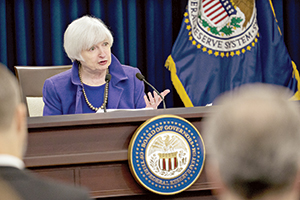Trucking Ready for Increases as Interest Rate Hikes Begin

The Federal Reserve raised interest rates Dec. 16, announcing a quarter-point increase from the record lows set during the financial crisis of the 2008-2009 recession.
The Fed also signaled that move was the first of rate increases to come as the U.S. economy slowly continues to improve.
The 10-0 decision by the central bank’s top policymakers marks the first increase in the federal funds target rate since the first half of 2006. The federal funds rate is what banks charge each other for overnight loans so they can comply with reserve requirements.
At the conclusion of its two-day meeting in Washington, the Federal Open Market Committee raised the new target rate to 0.25% to 0.5% per year, up from the previous range of 0% to 0.25%, where it had been since December 2008.
“The Fed’s decision today reflects our confidence in the U.S. economy,” Chair Janet Yellen said at a news conference.
Trucking executives and other executives said the Fed’s action will work its way through the financial sector and increase rates for tractor and trailer financing and for lines of credit, probably the two most common types of borrowing used by motor carriers.
Bob Costello, chief economist of American Trucking Associations, said the increase has been expected for a long time and that he thinks it will help trucking.
“This is a good thing. It shows that the Fed thinks the economy can withstand the increase,” Costello said.
The Federal Open Market Committee meets eight times a year, and Costello said he thinks the federal funds target will be 1% or 1.25% a year from now, meaning a probable quarter-point increase every three months.
The timing of the announcement is good, a bank economist said, because the Fed can raise rates slowly at this point rather than in a hurry — and fast increases can do a lot of damage.
“It’s a matter of pay me now or pay me later,” said Michael Gregory, deputy chief economist of BMO Capital Markets in Chicago.
“The economy is doing well and doesn’t need near-zero rates anymore. This also gives the Fed more power later,” he said. BMO Financial Group bought a large portion of GE Capital’s transportation lending portfolio earlier this year.
Gregory and Costello agreed that it is now important to return rates to a higher, more normal level.
Part of the reason is that if there is another recession, the Fed can’t go lower than zero. Rate increases during relative prosperity allow the central bank to stimulate the economy with decreases.
Yellen and her colleagues said inflation is low and the economy is generally growing, even if not in all industries.
Two chief financial officers for trucking companies took the announcement in stride.
“A quarter of a percentage point won’t have a tremendous impact right now, but it may be an indicator for the future,” said Bart Middleton of tank truck carrier Grammer Industries in Grammer, Indiana.
Middleton said he expects rates for trucking company lines of credit and equipment financing to start going up. He said the increases will come out of carriers’ operating ratios, as he doubts they can impose rate increases to cover interest costs.
He endorsed a slow series of rate increases rather than a fast change.
“If rates go back up rapidly, it will have an impact,” Middleton said.
Terry Croslow of truckload carrier Venture Express in LaVergne, Tennessee, said the Fed is starting its increases “from a very low point,” which makes them less damaging.
Loans for trucking are usually priced in terms of percentage points above a base rate, either prime or LIBOR, the London Interbank Offered Rate.
Both of the bases should start rising, Croslow said, meaning trucking companies have to convince lenders to keep the added increment as low as possible.
Interest rates are very important for truckers, Croslow said, but for now, he said, he is more interested in hours-of-service relief and tax law. Making bonus depreciation for equipment purchases permanent would be much more important for company finances, he said, than the start of interest-rate increases.
Croslow and Middleton are active in the National Accounting & Finance Council of American Trucking Associations.
ATA’s Costello said the increase could push homebuilders into starting projects more quickly than otherwise. There was no penalty for waiting while rates were low and flat, but now that they’re rising, builders have a reason to move quickly, he said.
Croslow said that if that analysis is accurate, it would be very helpful for trucking companies that haul building materials and home furnishings.

